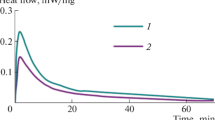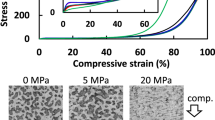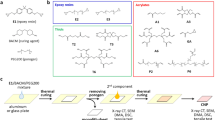Abstract
Epoxy porous monoliths were prepared from a commercial epoxy resin, D.E.R. 331, that cured with a tertiary amine, 2,4,6-tris-(dimethylaminomethyl) phenol, in the presence of a solvent, diisobutyl ketone (DIBK). During the curing process, polymers were formed and a decrease in its solubility in DIBK; the solution thus phase-separated, usually referred to as chemically induced phase separation. The phase separation formed interconnected polymer-poor phase that then became interconnected pores after the removal of DIBK. By varying the content of DIBK from 32 to 40 vol.%, epoxy monoliths with interconnected pores were prepared, with surface pore size ranging from 0.20 to 2.33 μm, overall porosity from 0.41 to 0.60, and ethanol permeability from 10 to 4,717 L/(m2 h−1 bar−1). The glass transition temperatures of the epoxy monoliths, measured with differential scanning calorimetry, were all higher than 100 °C, and temperatures of 5 % weight loss, analyzed by thermal gravimetry, were higher than 350 °C, evidencing the monoliths’ high thermal stability. Also, the monolith morphology was found to be strongly related to the reaction mechanism of polymerization. The results indicate that the mechanism of chain initiation and propagation associated with the tertiary amine can effectively form monoliths with interconnected pores, which cannot be easily prepared with a stepwise polymerization mechanism associated with using primary amine as the curing agent.











Similar content being viewed by others
References
Sotiropoulou S, Vamvakaki V, Chaniotakis NA (2005) Biosens Bioelectron 20(8 SPEC. ISS):1674
Huck CW, Bonn GK (2005) Chem Eng Technol 28(12):1457
Barbetta A, Carnachan RJ, Smith KH, Zhao CT, Cameron NR, Kataky R, Hayman M, Przyborski SA, Swan M (2005) Macromol Symp 226(1):203
Higuchi A, Shindo Y, Gomei Y, Mori T, Uyama T, Umezawa A (2005) J Biomed Mater Res B Appl Biomater 74(1):511
Safinia L, Mantalaris A, Bismarck A (2006) Langmuir 22(7):3235
Romeo HE, Vílchez A, Esquena J, Hoppe CE, Williams RJJ (2012) Eur Polym J 48(6):1101
Svec F, Kurganov AA (2008) J Chromatogr A 1184(1–2):281
Varilova T, Madera M, Pacakova V, Stulik K (2006) Curr Proteomics 3(1):55
Zilberman M (2005) Acta Biomater 1(6):615
**e S, Svec F, Fréchet JMJ (1998) Chem Mater 10(12):4072
Svec F, Fréchet JMJ (1999) Ind Eng Chem Res 38(1):34
Peters EC, Svec F, Fréchet JMJ, Viklund C, Irgum K (1999) Macromolecules 32(19):6377
Kiefer J, Hedrick JL, Hilborn JG (1999) Macroporous thermosets by chemically induced phase separation. Adv Polym Sci 147:161–247
Kiefer J, Hilborn JG, Hedrick JL, Cha HJ, Yoon DY, Hedrick JC (1996) Macromolecules 29(26):8546
Della Martina A, Hilborn JG, Mühlebach A (2000) Macromolecules 33(8):2916
Garcia Loera A, Dumon M, Pascault JP (2000) Macromol Symp 151:341
Ai H, Xu K, Chen W, Liu H, Chen M (2009) Polym Int 58(1):105
Luo YS, Cheng KC, Huang ND, Chiang WP, Li SF (2011) J Polym Sci B Polym Phys 49(14):1022
Kiefer J, Hilborn JG, Hedrick JL (1996) Polymer 37(25):5715
Kiefer J, Hilborn JG, Månson JAE, Leterrier Y, Hedrick JL (1996) Macromolecules 29(11):4158
Loera AG, Cara F, Dumon M, Pascault JP (2002) Macromolecules 35(16):6291
Williams RJJ, Rozenberg BA, Pascault JP (1997) Adv Polym Sci 128:95
Tsujioka N, Ishizuka N, Tanaka N, Kubo T, Hosoya K (2008) J Polym Sci A Polym Chem 46(10):3272
Han JL, Hsieh KH, Chiu WY (1993) J Appl Polym Sci 50(6):1099
Dzhavadyan EA, Bogdanova LM, Irzhak VI, Rozenberg BA (1997) Polym Sci Ser A 39(4):383
Dell’Erba IE, Williams RJJ (2006) Polym Eng Sci 46(3):351
Kuzub LI, Irzhak VI (2001) Colloid J 63(1):86
Chakrabarty B, Ghoshal AK, Purkait MK (2008) J Colloid Interface Sci 320(1):245
Chen JL, Chang FC (2001) Polymer 42(5):2193
Vazquez A, Bentaleb D, Williams RJJ (1991) J Appl Polym Sci 43(5):967
Rozenberg B (1986) Kinetics, thermodynamics and mechanism of reactions of epoxy oligomers with amines. Adv Polym Sci 75:113–165
Shechter L, Wynstra J, Kurkjy RP (1956) Ind Eng Chem 48(1):94
Cheng KC, Don TM, Rwei SP, Li YC, Duann YF (2002) J Polym Sci B Polym Phys 40(17):1857
Winter HH, Chambon F (1986) J Rheol 30(2):367
Acknowledgment
We thank the National Science Council of Taiwan for the financial support of this study under Contract NSC 97-2221-E-027-013-MY2.
Author information
Authors and Affiliations
Corresponding author
Electronic supplementary material
Below is the link to the electronic supplementary material.
ESM 1
(PDF 517 kb)
Rights and permissions
About this article
Cite this article
Luo, YS., Cheng, KC., Wu, CL. et al. Preparation of epoxy monoliths via chemically induced phase separation. Colloid Polym Sci 291, 1903–1912 (2013). https://doi.org/10.1007/s00396-013-2926-9
Received:
Revised:
Accepted:
Published:
Issue Date:
DOI: https://doi.org/10.1007/s00396-013-2926-9




